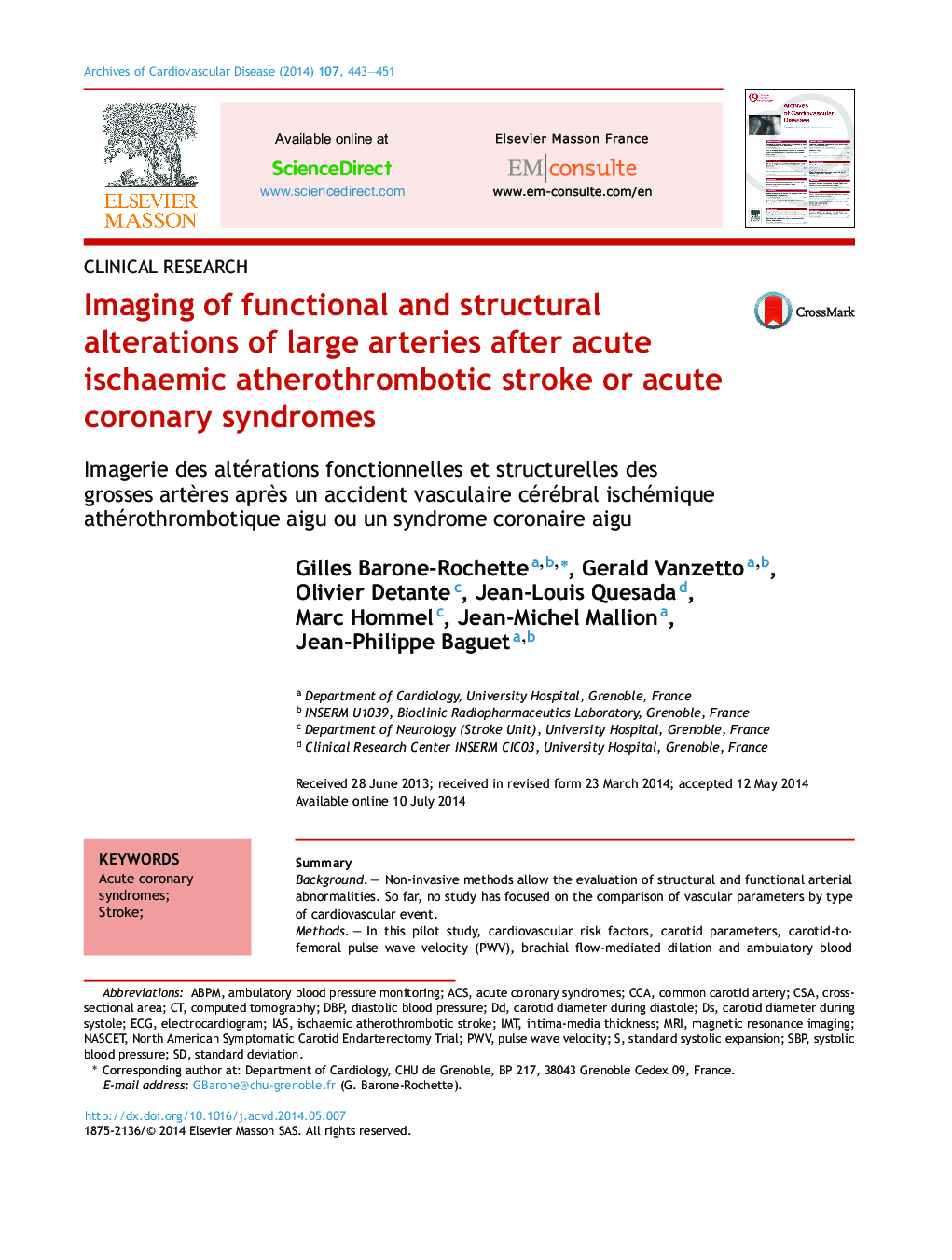| کد مقاله | کد نشریه | سال انتشار | مقاله انگلیسی | نسخه تمام متن |
|---|---|---|---|---|
| 2888920 | 1574352 | 2014 | 9 صفحه PDF | دانلود رایگان |
SummaryBackgroundNon-invasive methods allow the evaluation of structural and functional arterial abnormalities. So far, no study has focused on the comparison of vascular parameters by type of cardiovascular event.MethodsIn this pilot study, cardiovascular risk factors, carotid parameters, carotid-to-femoral pulse wave velocity (PWV), brachial flow-mediated dilation and ambulatory blood pressure were assessed in patients who presented with acute coronary syndromes (ACS) or ischaemic atherothrombotic stroke (IAS). Groups were matched for age and gender.ResultsPrevalences of hypertension, diabetes and dyslipidaemia and heredity, smoking and body mass index were similar in the ACS (n = 50) and IAS (n = 50) groups. Carotid intima-media thickness (IMT) and PWV were significantly higher in the IAS vs. ACS group (769 ± 180 vs. 701 ± 136 μm; P = 0.039 and 12.5 ± 3.5 vs. 10.7 ± 2.4 m/s; P = 0.006). Carotid distensibility was significantly lower in the IAS vs. ACS group (16.2 ± 3.2 vs. 18.9 ± 7.6 10−3/kPa; P = 0.02). These differences persisted after adjustment for blood pressure for carotid distensibility but not for PWV. The prevalences of endothelial dysfunction and carotid plaques were not significantly different in the ACS and IAS groups (86% and 74%; 80% and 78%). In a multivariable model, carotid distensibility remained associated with ACS (odds ratio 1.19; 95% confidence interval 1.03–1.38; P = 0.016).ConclusionsStiffness and carotid wall thickness were higher in IAS than in ACS patients. These differences may support the interest in new therapeutic targets for cardiovascular secondary prevention.NCT NoNCT00926874.
RésuméContexteDes méthodes non invasives permettent maintenant d’évaluer les anomalies structurelles et fonctionnelles des artères. Aucune étude à ce jour n’a comparé ces anomalies selon l’événement athérothrombotique aigu.MéthodesDans une étude pilote, les facteurs de risque cardiovasculaires, les paramètres carotidiens, la vitesse de l’onde de pouls (VOP), la dilatation de l’artère humérale médiée par le flux et la pression artérielle (PA) ambulatoire ont été évaluées chez patients qui ont présenté soit un syndrome coronarien aigu (SCA) ou un accident vasculaire cérébral (AVC) ischémique athérothrombotique (AVC), appariés pour l’âge et le sexe.RésultatsLa prévalence de l’hypertension artérielle, le diabète, la dyslipidémie, l’hérédité, le tabagisme et l’indice de masse corporelle étaient similaires dans les SCA (n = 50) et AVC (n = 50) groupes. L’épaisseur intima-média carotidienne (EIM) et la VOP étaient significativement plus élevée dans le groupe AVC vs SCA (769 ± 180 vs 701 ± 136 μm ; p = 0,039 et 12,5 ± 3,5 vs 10,7 ± 2,4 m/s ; p = 0,006). La distensibilité carotidienne (DC) était significativement plus faible dans le groupe AVC vs SCA (16,2 ± 3,2 vs 18,9 ± 7,6 10−3/kPa ; p = 0,02). Cette différence persistait pour la DC après ajustement pour la PA moyenne, mais pas pour la VOP. Les prévalences de la dysfonction endothéliale et des plaques carotidiennes n’étaient pas significativement différent dans les SCA et AVC groupes (86 % vs 74 % et 80 % vs 78 %). En analyse multivariée, DC restait associée à la survenue d’un SCA (rapport de cotes 1,19 ; 95 % intervalle de confiance 1,03–1,38 ; p = 0,016).ConclusionsChez les patients victimes d’un AVC ischémique athérothrombotique, la rigidité et l’épaisseur de la paroi carotidienne était plus élevé que chez les patients victime d’un SCA. Ces différences peuvent indiquer l’intérêt potentiel de nouvelles cibles thérapeutiques dans la prévention secondaire cardiovasculaire.NCT noNCT00926874.
Journal: Archives of Cardiovascular Diseases - Volume 107, Issues 8–9, August–September 2014, Pages 443–451
